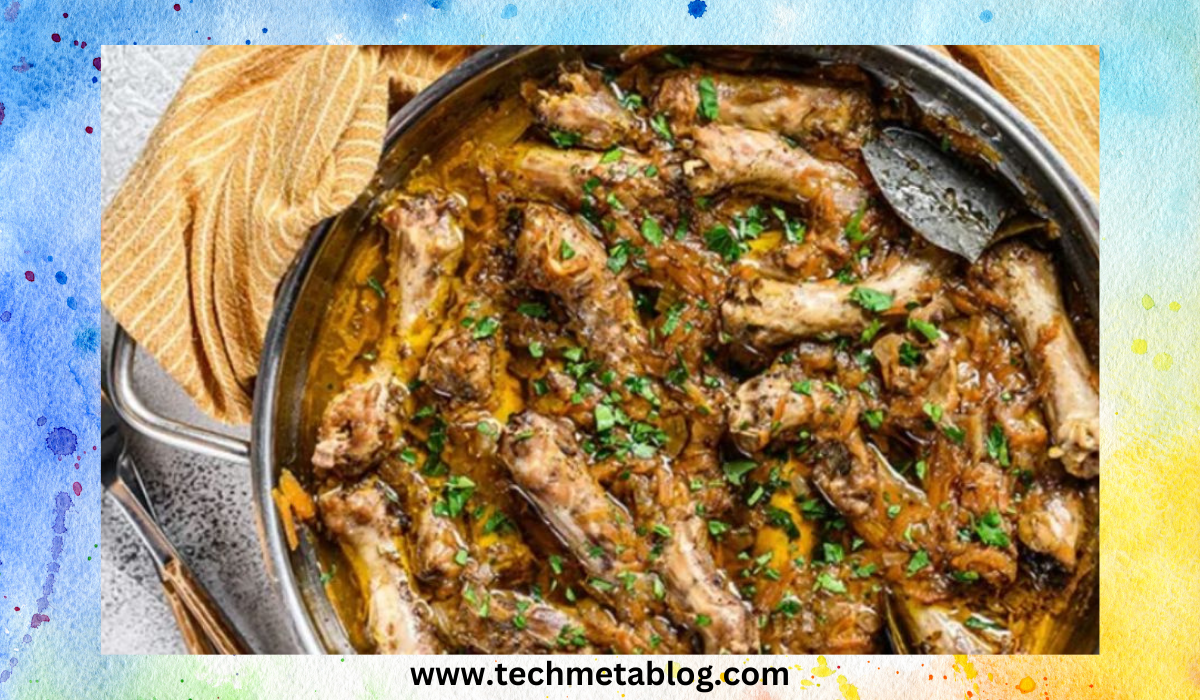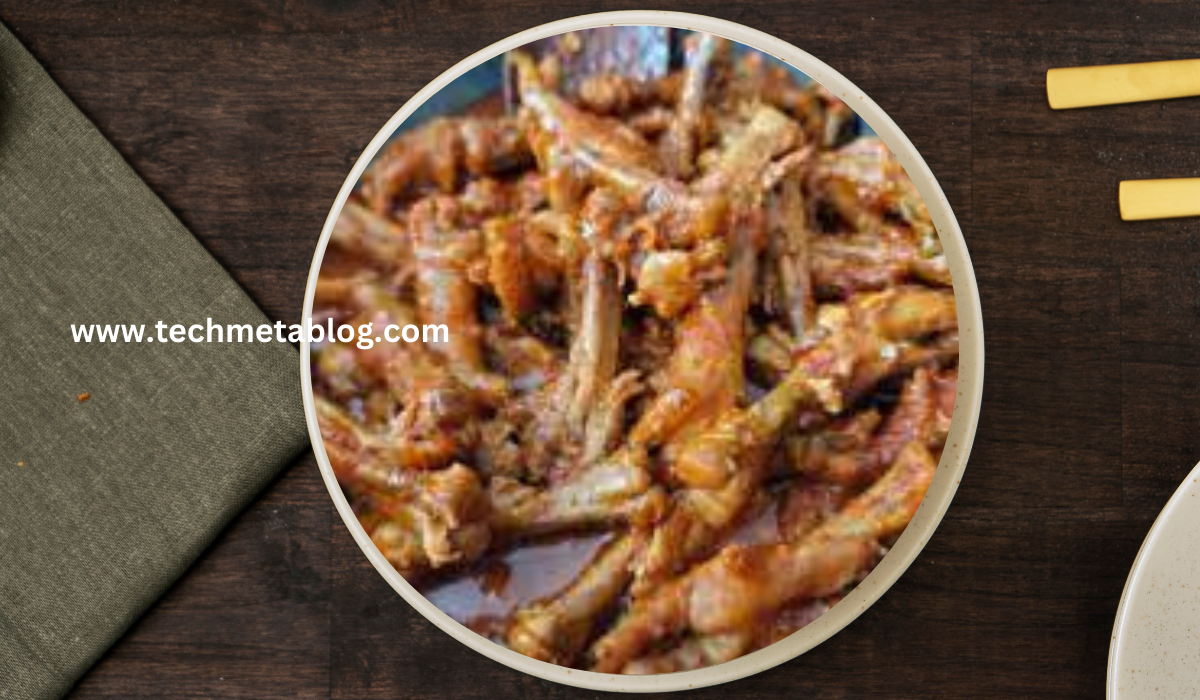Another factor that made chicken neck soup Georgi Dinkov’s presentation is its fantastic taste and many health benefits. Here, the traditional dish centers itself on chicken necks, usually viewed as scraps and inessential to acquire, but pay them their due respect as a healthy, nutritious soup. With packed nutrients including collagen, vitamins, and minerals, chicken neck soup combines unique means of boosting your health with enjoyable moments of tempting food. This article speaks to the recipe, nutrition stats, and frequently asked questions relating to chicken neck soup, so you are well-equipped and ready to make this delicious dish.
What is Chicken Neck Soup?
Chicken neck soup is a savory soup prepared primarily from chicken necks, which are accompanied with other vegetables and spices. Chicken necks are mainly discarded or underappreciated by most people. Such intake of chicken necks brings in a rich depth of flavor to the soup. In the process of cooking, the collagen in the necks gets broken down, resulting in the provision of a nourishing broth, which is both palatable and of health benefit.
History and Cultural Significance
Chicken neck soup is very simple in its ingredients, though, whose roots can be seen across the globe in various cuisines. Using every piece of the animal is economical but a sign of respect for the food being prepared. For example, hearty leftover or less-popular-cut soups constitute a common fare from Eastern European counties, with the latter oftentimes reflecting a sustainable cooking approach nothing will be wasted.
Southern cuisine, largely of African American communities, carries a long history about neck meat. Many foods prepared from chicken necks have received much attention, and the taste is highly cherished. Chicken necks are also used in soup and stew in Latin American cooking-a versatile, would-be poor man’s ingredient, for sure. Culture significance deepens the soup to be more than just a meal but as a passage connecting this heritage with the present day.
Nutritional Benefits of Chicken Neck Soup
Nutritional Profile
The table below represents the nutritional profile per serving of chicken neck soup in a cup:
| Nutrient | Amount per Serving | Daily Value Percentage |
|---|---|---|
| Calories | 150 | 8% |
| Protein | 20 g | 40% |
| Fat | 6 g | 9% |
| Carbohydrates | 5 g | 2% |
| Fiber | 1 g | 4% |
| Vitamin A | 1000 IU | 20% |
| Vitamin C | 2 mg | 3% |
| Calcium | 30 mg | 3% |
| Iron | 1.5 mg | 8% |
Essential Nutrients Described
- Protein: The chicken necks contain high quality proteins required in the repair of muscles, but essential for maintaining an active immune system and the general upkeep of the body. The other physiological utilization of protein includes hormone and enzyme production.
- Collagen: This essential protein contributes to joint and skin elasticity. Intake of collagen rich foods may help improve the appearance of the skin, reduce joint pain. Recent studies suggest that dietary intake of collagen may benefit significantly joint health, mainly in the elderly, when degeneration commonly occurs in joints.
- Vitamins and Minerals: A number of vegetables are used in the preparation of this soup. These will contribute to the soup with vitamins A and C. This would definitely improve eye health and provide immunity. Vitamin A is required for good vision, and Vitamin C in your diet greatly aids an immune response. Calcium in the soup helps ensure proper bone mass. Iron in the soup ensures one energized. A diet rich in such vitamins and minerals can help to prevent deficiencies that can lead to additional health problems.
Health Benefits
- Collagen Source: The most benefit that you can derive from chicken necks is their rich collagen source that comprise an important ingredient for healthy skin and joints and connective tissue in the body. That is why collagen stands as a fount of youth, helping diminish wrinkles and keep the skin hydrated.
- Low in Calories: Chicken neck soup is fairly low calorie, thus a good option for dieting weight management. It will definitely provide an excellent alternative for some of the heavier, more creamy soups where you can rather prepare filling meals without the abuse of excessive calories.
- Immune Support: This aside, some ingredients in the chicken neck soup recipe like garlic and onions assist in building up the immune system. These health effects go beyond just preventing a disease. Thirdly, garlic is so potent that it helps fight up some anti-inflammatory and antimicrobial properties that help ward off various illnesses.
- Hydration: The soup is also a type of broth-based food that will hydrate; fluids will be very scarce without the consumption of such a soup. Its higher water content contributes to additional support in kidney function and helps flush out toxins from the body system.
- Digestive Health: The soup may improve digestive health since the warm comforting nature of the soup might ease the digestive system making the pain less acute. A warm bowl of chicken soup definitely works well for something concerning the digestive system, as it can be pretty soothing to the stomach and may even help with digestion to a great extent.
- An Economical Component: Chicken necks are one of the cheapest ingredients you may use in preparing meals. They happen to be very suitable for families that are on a tight budget, thereby highlighting how nutritious meals can be made from even the most affordable ingredients.
Georgi Dinkov’s Chicken Neck Soup
Servings: 4-6
Ingredients
- 1 pound chicken necks
- 4 cups water or chicken broth
- 1 medium onion, chopped
- 2 carrots, sliced
- 2 celery stalks, diced
- 3 garlic cloves, minced
- Salt and pepper to taste
- Fresh herbs (e.g., parsley or dill) for garnish
- Optional: 1-2 bay leaves, 1 teaspoon of thyme
Cooking Equipment
- Large pot or Dutch oven
- Strainer (if desired)
- Cutting board and knife
- Ladle for serving
Instructions
- Preparation: Under cold running water, rinse the chicken necks well and pat dry. In this way, it can remove residues of blood and impurities for consumption so that its soup tastes cleaner in the last stage.
- Sauté the vegetables: Chop and add some oil to a large pot. Add the chopped onion, carrots, and celery and sauté until the vegetables soften. Generally, this takes about 5 minutes. This breaks down the sugars and other flavors that are bound in the vegetables and gives a great soup base.
- Add Chicken Neck: Place the chicken necks in the pot and allow them to sauté for an additional 3-4 minutes with slight browning. Browning the meat enhances the depth of flavor within the soup and elevates its taste altogether.
- Add Liquid: Pour over water or chicken broth enough to cover necks. Bring a boil up over high, then cut back to a simmer. This will allow flavors to meld together and collagen to begin to break down.
- Simmer: Simmer the soup 1 to 2 hours, or until the flavors have dissolved into each other and the collagen liquidized the necks. Skim off any foam or impurities that rise to the surface in the course of cooking. That yields a clearer broth and much more flavour.
- Strain and Season: Remove the necks, strain the broth if desired and season with salt and freshly ground pepper to taste. Fresh herbs can be added for additional flavor during the last few minutes of cooking.
- Serve: Ladle the soup into bowls, garnishing with fresh herbs. Hot over crusty bread or a side salad.
Options for Adaptation
Chicken neck soup can be adapted to individual preferences, including special needs or restrictions. Some of the suggestions may include:
Some ways of introducing rich flavor and rich nutritious value include
- Adding vegetables: Such as potatoes, zucchini, or bell peppers, for nutrients. The vegetables added would add texture and vitamin-rich and mineral content in the soup.
- Spices: Bay leaves, thyme, or rosemary add deeper flavor. The red pepper flakes add some subtle warmth, if one enjoys a little spice.
- Proteins: Add one of meat so the soup feels slightly heartier. Chicken wings or chicken thighs work well. Adding tofu or beans makes it enough for a vegetarian version, which makes it more filling and diverse.
- Acidity: A pinch of vinegar or lemon juice may be required to activate the flavors of the soup. Acidity is just what balances richness in broth and makes the soup rather refreshing.
- Herbs: Try using fresh herbs like cilantro, basil, or chives for that magical touch in the soup. It somehow elevates its flavor profile.
Cooking Methods to Enhance Your Chicken Neck Soup
1. Roasting the Bones
Another good approach to making your chicken neck soup really flavourful is by roasting the necks before including them in the pot. Roasting deepens the umami taste of the ingredients into an intenser broth. So, set your oven to 400 degrees Fahrenheit/200 degrees Celsius. Line the chicken necks out in one layer on a baking sheet and roast for about 20-25 minutes till they turn brownish. This helps deepen flavor and adds layers to your soup.
2. Cold Water Extraction
Make your broth with cold water to extract the best in nutrients. Put the chicken necks into your pot and cover them with cold water. Now, let that water boil. Then, bring the water to the boil. It lets out collagen and minerals slowly. That way, you get a richer flavor of your broth.
3. Stock vs. Broth
Understand stock versus broth. Stock refers to simmering bones (with or without meat) for a long period of time, while broth is usually made from meat and is cooked for a much shorter amount of time. Actually, when you’re cooking chicken neck soup, you can apply either of the two, but to be gelatinous and thick, you opt for the former stock-making method.
Chicken Neck Soup in Pop Culture
Chicken neck soup has not only been a staple in many kitchens but also features in different versions in popular culture. From cookbooks to television programs, it epitomizes comfort and nourishment. It is home cooking and family get-to-gather in so many cultures, underlining the emotional bond people have with food.
Cookbooks and Food Shows
Whether in the culinary kitchen or in one’s home, chicken neck soup is a dish that many professional and amateur chefs have mastered. Programs such as “Chopped” and “Top Chef” typically require participants to use parts of the chicken, displays dishes including snacks with ingredients like necks and wings. These programs stimulate sustainability and creativity in cooking; challenge the viewer to think differently, out of the box regarding cuts of meat.
Social Media and Food Trends
Now, social media also contributed to a further hike of chicken neck soup popularity. Social media in this case of Instagram and TikTok saw people trying out varied recipes of soups and posting them, mostly traditional soups, as can be in the case with chicken neck soup. Food influencers and bloggers also posted their versions of it, thus sparking interest for this relatively cheap healthy meal.
FAQs About Chicken Neck Soup
1. Do I Have the Option to Use Other Parts of Chicken?
Absolutely, you can use other chicken parts such as wings, backs, or thighs besides necks. Mixing these might add different layers of flavor and richness to the soup.
2. How Long Does It Take to Cook Chicken Neck Soup?
This chicken neck soup has a cooking time of around 1-2 hours, by which time all flavors should have melded and the collagen well extracted. That said, if you happen to own a pressure cooker, you can significantly cut that cooking time, and the soup will be ready in about 30-45 minutes.
3. Can I use store-bought broth?
You can buy a store-bought chicken broth, but if you really want to bring richness and a whole lot of goodness into your dish, you better make that broth from scratch. Low-sodium options should be used in case you are on a low-sodium diet.
4. Can I Freeze Chicken Neck Soup?
Chicken neck soup does very well in the freezer. It may be kept for as long as 3 months in freezer-safe containers. Before heating up, you’ll need some water to loosen it up because the consistency often thickens up some when frozen.
5. How Can I Make Chicken Neck Soup More Flavorful?
Adding herbs and spices, or even a splash of vinegar, to the soup itself enhances flavour dimensions. Other vegetables also add new flavours to the recipe. Sometimes, you can even roast vegetables before adding them to the soup in order to enhance their natural flavours.
6. Is Chicken Neck Soup Good for Children?
Yes, chicken neck soup is very safe to consume by kids. Being tasteful and soft, it can readily be a nutritious food for kids. In fact, you can liquefy the soup if the child is really young so that it becomes easier for him to feed on.
7. How to store leftover chicken necks before the next use?
Chicken necks will keep in an airtight container in the refrigerator for up to 3 days or may be frozen for further storage and then used in future soups or stews.
8. Can I Make Chicken Neck Soup in a Slow Cooker?
You can make chicken neck soup in the slow cooker. All you need to do is add all the ingredients and then cover those with water. Cook on the low for 6-8 hours or on the high for 3-4 hours to result in just the right flavors.
9. What can I eat with Chicken Neck Soup?
Chicken neck soup can go very well with some crusty bread or crackers, or a fresh green salad. The accompaniments add a nice texture with a mix of it to the meal.
10. Can You Prepare a Vegetarian Version of Chicken Neck Soup?
Now that we have the classic chicken neck soup using chicken necks, a vegetarian version would be ready to go by substituting these with vegetable broth and other vegetables. You can add protein and some texture to the soup with mushrooms, beans, or lentils.
Conclusion
Georgi Dinkov’s chicken neck soup is an excellent example of how simple ingredients can have great health benefits and flavor. This soup illustrates the need to use every part of the chicken, but it is also a nourishing dish that would go well in a healthy diet. Adding chicken neck soup to your list of culinary arts should give you the satisfaction of enjoying comfort food but also provide the opportunity to derive the nutritional benefits from the soup.
Chicken neck soup could alter your conception of comfort food-both nourishing and gratifying. With its numerous health benefits coupled with the delightful flavors it brings to your table, this hearty dish is well worth plunging into. Be it for that bowl of warm soup on a cold, drizzly day or just as a healthy meal option, this chicken neck soup could be satisfying indeed. Enjoy the rich history, nutritional benefits, and comforting flavors that come in with each spoonful. In making this soup a staple in your kitchen, you connect to a tradition that respects food, promotes health, and delights the palate. So, gather your ingredients and taste the wholesome goodness of chicken neck soup today!
Other Resources
For more information on chicken neck soup and its benefits, check out the following resources:
- The Benefits of Collagen
- Healthy Soup Recipes for All Seasons
- The Guide on How to Make the Perfect Broth
With this article, you’re going to learn in full how chicken neck soup is developed, its health advantages, ways of preparing it, and its cultural significance. Now that you have gotten to know what this guide has in store for you, go ahead and make a scrumptious meal that will keep you and your body well-nourished. Happy cooking!
Also read more : 3d659.com blog

